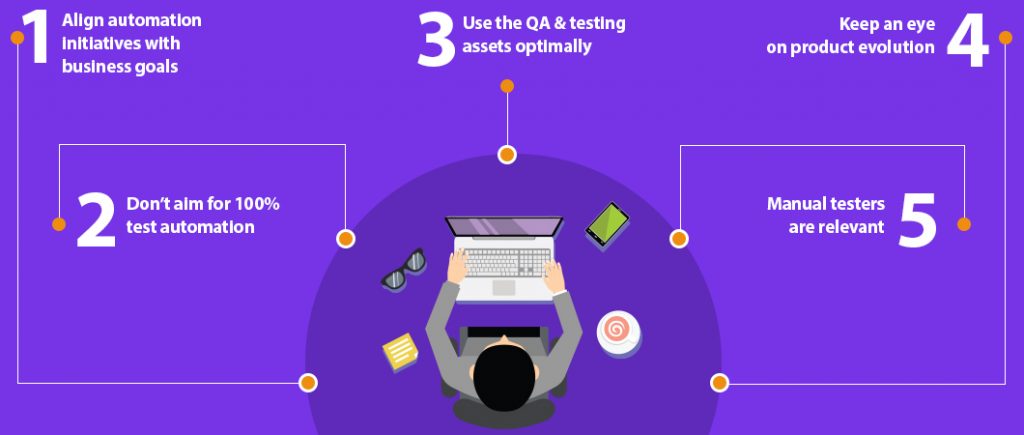Last updated on December 29th, 2022
What do you think is common to most modern development approaches such as DevOps, Agile, BDD, TDD, etc.? Simply that these software development methodologies always aim to increase the speed of development and consequent deployment. And, in doing so, they also place testing at the heart of development.
You will agree that today, customers have zero tolerance for faulty or defective software products and testing has become central to product development. No longer can testing be considered the stepchild of development. In fact, if you want to develop robust software products faster, then testing and test automation have to rank ever higher on the development priority list.
Then there is also the need to deploy software faster. Most surveys, like sauce Labs’ “Testing Trends in 2017 – A Survey of Software Professionals”, say the same thing. That to varying degrees, even approaching obsessiveness, software development teams are focused on deploying software faster!
These are tectonic shifts in development and one direct consequence has been the growing need to automate testing. Estimates are that the test automation market is all set to expand at a CAGR of 15.4% from 2017 to 2025 and expected to cross US$ 109.69 billion by 2025.
So, clearly, you need test automation to develop error-free and robust software products. At the same time, automation initiatives demand investments and it is only fair that your organization demands an impressive ROI, delivered quickly. So what must you do to ensure that the testing process is effectively automated to deliver the returns you expect?
1. Align automation initiatives with business goals
Aligning testing with the desired business goals of the software under development is the first step towards effective automation initiatives. Those tasked with developing a relevant testing suite, must:
- Define the functional and non-functional requirements of the software being developed
- Discuss these requirements with the development team to gain greater product understanding
- Design the test suite to ensure maximum code coverage that goes beyond testing boundary code conditions and extends to testing the implementation of the requirement
2. Don’t aim for 100% test automation
With great power comes greater responsibility! While test automation holds the promise of great speed, it’s important to focus. Identify the best candidates for automation first. Aiming for 100% automation WILL result in disaster mainly because of the complexities involved with testing that demand human judgment. There are only those many candidates that lend themselves to effective automation. Why? Simply because test automation works within defined boundaries and hence is great for time-consuming repeatable tests such as regression testing.
3. Use the QA & testing assets optimally
Optimal utilization of ALL your QA and testing assets goes a long way in ensuring effective test automation. In case you are wondering, your QA assets are all the contributors and stakeholders that directly impact your software development initiatives. So, your automation engineers, manual testers, product owners, test design, test cases, test infrastructure, testing tools, and test data all become a part of your asset pool. It makes sense to utilize all these assets optimally to ensure a positive ROI.
If you want to know more then we can plan to take a deep dive into these in one of our future blogs
4. Keep an eye on product evolution
This is the age of frequent product iterations and upgrades. For successful test automation, it is essential to keep product evolution insight. An effective automation strategy considers the use of reusable test cases, ensures test plans that remain relevant, has smaller and independent test cases instead of a huge monolithic architecture, etc. Additionally, building flexible test suites, identifying the maintenance needs of these suites, employing the use of test data to identify test cases that can be used in other environments makes the entire test automation suite stay relevant for longer.
5. Manual testers are relevant
What are manual testers doing in the age of automation? Contrary to what some may have you believe, manual testers are very important to test automation. Test automation is great for tests that are time and resource-intensive. However, you need the manual testers to leverage their domain and testing knowledge to successfully execute test automation initiatives. Automation can assess if all the moving parts are working correctly, but it is the manual testers who can assess if all things are working as designed on a contextual level. We believe in this strongly, in fact, we’ve written a blog that makes this case in much greater detail!
In closing, it is important to remember that the true value of automation testing does not lie in the volume of tests. It lies, instead, in assessing correctly when to automate and how much to automate. At the end of the day, your test automation initiative will deliver value when it allows you to achieve maximum test coverage in the minimum possible time with the least effort. Once that is clear, the effective implementation of test automation initiatives will become easier – we promise!



